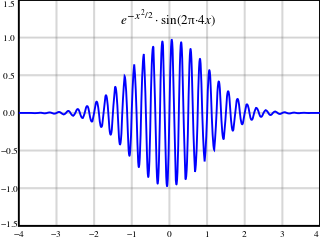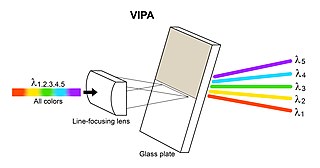Refractive index contrast, in an optical waveguide, such as an optical fiber, is a measure of the relative difference in refractive index of the core and cladding. The refractive index contrast, Δ, is often given by , where n1 is the maximum refractive index in the core and n2 is the refractive index of the cladding. The criterion n2 < n1 must be satisfied in order to sustain a guided mode by total internal reflection. Alternative formulations include and . Normal optical fibers, constructed of different glasses, have very low refractive index contrast (Δ<<1) and hence are weakly-guiding. The weak guiding will cause a greater portion of the cross-sectional Electric field profile to reside within the cladding as compared to strongly-guided waveguides. Integrated optics can make use of higher core index to obtain Δ>1 allowing light to be efficiently guided around corners on the micro-scale, where popular high-Δ material platform is silicon-on-insulator. High-Δ allows sub-wavelength core dimensions and so greater control over the size of the evanescent tails. The most efficient low-loss optical fibers require low Δ to minimise losses to light scattered outwards.

The vertical-cavity surface-emitting laser is a type of semiconductor laser diode with laser beam emission perpendicular from the top surface, contrary to conventional edge-emitting semiconductor lasers which emit from surfaces formed by cleaving the individual chip out of a wafer. VCSELs are used in various laser products, including computer mice, fiber optic communications, laser printers, Face ID, and smartglasses.

A fibre-optic gyroscope (FOG) senses changes in orientation using the Sagnac effect, thus performing the function of a mechanical gyroscope. However its principle of operation is instead based on the interference of light which has passed through a coil of optical fibre, which can be as long as 5 kilometres (3 mi).

Double-clad fiber (DCF) is a class of optical fiber with a structure consisting of three layers of optical material instead of the usual two. The inner-most layer is called the core. It is surrounded by the inner cladding, which is surrounded by the outer cladding. The three layers are made of materials with different refractive indices.
A fiber laser is a laser in which the active gain medium is an optical fiber doped with rare-earth elements such as erbium, ytterbium, neodymium, dysprosium, praseodymium, thulium and holmium. They are related to doped fiber amplifiers, which provide light amplification without lasing.

A frequency comb or spectral comb is a spectrum made of discrete and regularly spaced spectral lines. In optics, a frequency comb can be generated by certain laser sources.

Silicon photonics is the study and application of photonic systems which use silicon as an optical medium. The silicon is usually patterned with sub-micrometre precision, into microphotonic components. These operate in the infrared, most commonly at the 1.55 micrometre wavelength used by most fiber optic telecommunication systems. The silicon typically lies on top of a layer of silica in what is known as silicon on insulator (SOI).

In optics, a supercontinuum is formed when a collection of nonlinear processes act together upon a pump beam in order to cause severe spectral broadening of the original pump beam, for example using a microstructured optical fiber. The result is a smooth spectral continuum. There is no consensus on how much broadening constitutes a supercontinuum; however researchers have published work claiming as little as 60 nm of broadening as a supercontinuum. There is also no agreement on the spectral flatness required to define the bandwidth of the source, with authors using anything from 5 dB to 40 dB or more. In addition the term supercontinuum itself did not gain widespread acceptance until this century, with many authors using alternative phrases to describe their continua during the 1970s, 1980s and 1990s.

Coherent addition of lasers is a method of power scaling. It allows increasing the output power and brightness of single-transversal mode laser.

A disk laser or active mirror (Fig.1) is a type of diode pumped solid-state laser characterized by a heat sink and laser output that are realized on opposite sides of a thin layer of active gain medium. Despite their name, disk lasers do not have to be circular; other shapes have also been tried. The thickness of the disk is considerably smaller than the laser beam diameter. Initially, this laser cavity configuration had been proposed and realized experimentally for thin slice semiconductor lasers.
Filling factor, is a quantity measuring the efficiency of absorption of pump in the core of a double-clad fiber.
The Institute for Laser Science is a department of the University of Electro Communications, located near Tokyo, Japan.
Power scaling of a laser is increasing its output power without changing the geometry, shape, or principle of operation. Power scalability is considered an important advantage in a laser design. This means it can increase power without changing outside features.
The IEEE Photonics Society, formerly the IEEE Lasers and Electro-Optics Society (LEOS), is a society of the Institute of Electrical and Electronics Engineers (IEEE), focused on the scientific and engineering knowledge about the field of quantum electronics. In the hierarchy of IEEE, the Photonics Society is one of the close to 40 technical societies organized under the IEEE Technical Activities Board.
Anthony E. Siegman was an electrical engineer and educator at Stanford University who investigated and taught about masers and lasers. Known to almost all as Tony Siegman, he was president of the Optical Society of America [now Optica (society)] in 1999 and was awarded the Esther Hoffman Beller Medal in 2009.
An optical modulator is an optical device which is used to modulate a beam of light with a perturbation device. It is a kind of transmitter to convert information to optical binary signal through optical fiber or transmission medium of optical frequency in fiber optic communication. There are several methods to manipulate this device depending on the parameter of a light beam like amplitude modulator (majority), phase modulator, polarization modulator etc. The easiest way to obtain modulation is modulation of intensity of a light by the current driving the light source. This sort of modulation is called direct modulation, as opposed to the external modulation performed by a light modulator. For this reason, light modulators are called external light modulators. According to manipulation of the properties of material modulators are divided into two groups, absorptive modulators and refractive modulators. Absorption coefficient can be manipulated by Franz-Keldysh effect, Quantum-Confined Stark Effect, excitonic absorption, or changes of free carrier concentration. Usually, if several such effects appear together, the modulator is called electro-absorptive modulator. Refractive modulators most often make use of electro-optic effect, other modulators are made with acousto-optic effect, magneto-optic effect such as Faraday and Cotton-Mouton effects. The other case of modulators is spatial light modulator (SLM) which is modified two dimensional distribution of amplitude & phase of an optical wave.
Ken-ichi Ueda is a Japanese laser scientist. He published more than 700 papers in international journals.
An erbium-doped waveguide amplifier is a type of an optical amplifier enhanced with erbium. It is a close relative of an EDFA, erbium-doped fiber amplifier, and in fact EDWA's basic operating principles are identical to those of the EDFA. Both of them can be used to amplify infrared light at wavelengths in optical communication bands between 1500 and 1600 nm. However, whereas an EDFA is made using a free-standing fiber, an EDWA is typically produced on a planar substrate, sometimes in ways that are very similar to the methods used in electronic integrated circuit manufacturing. Therefore, the main advantage of EDWAs over EDFAs lies in their potential to be intimately integrated with other optical components on the same planar substrate and thus making EDFAs unnecessary.

A virtually imaged phased array (VIPA) is an angular dispersive device that, like a prism or a diffraction grating, splits light into its spectral components. The device works almost independently of polarization. In contrast to prisms or regular diffraction gratings, the VIPA has a much higher angular dispersion but has a smaller free spectral range. This aspect is similar to that of an Echelle grating, since it also uses high diffraction orders. To overcome this disadvantage, the VIPA can be combined with a diffraction grating. The VIPA is a compact spectral disperser with high wavelength resolving power.
Andrew Marc Weiner OSA NAE NAI was an American electrical engineer, educator and researcher known for contributions to the fields of ultrafast optics and optical signal processing. He was the Scifres Family Distinguished Professor of Electrical and Computer Engineering at Purdue University.








